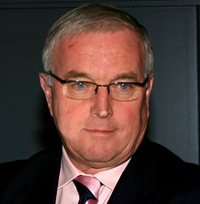Governing body hopes to take proactive role in development to prevent illegal products
 The International Cycling Union (UCI) organised a conference called “The UCI and the cycling industry” at the Eurobike trade fair in Friedrichshafen, Germany. The aim was, according to the UCI “to inform the industry’s leaders of the direction that the UCI is taking with regards the evolution, the regulations and the monitoring of equipment used during cycling events”.
The International Cycling Union (UCI) organised a conference called “The UCI and the cycling industry” at the Eurobike trade fair in Friedrichshafen, Germany. The aim was, according to the UCI “to inform the industry’s leaders of the direction that the UCI is taking with regards the evolution, the regulations and the monitoring of equipment used during cycling events”.
Present at the conference were UCI President Pat McQuaid and the new Equipment Consultant Professor Jan-Anders Månson. During the presentation both men stressed the “importance of intensifying the dialogue between the players in the cycling industry and the UCI”.
“They paid credit to the tremendous vitality of the cycling market and the amazing creativity of all involved,” says the UCI statement. “For the UCI President, this creativity contributes to the development of cycling, even more so when there is a close relation between the UCI and manufacturers.”
With manufacturers constantly searching for an extra edge, both from a performance and marketing perspective, often investing millions in research and development. The UCI, with this new initiative, hopes to make sure that this investment is not wasted.
Much of the UCI’s equipment regulations stem from the Lugano Charter, released in October 1996. The charter was created to prevent technology in bicycle development from becoming more important than the riders themselves, and to keep the sport affordable to all. Regulations now state that the bike’s wheels must be of equal diameter and that the frame must be of a conventional “diamond” shape.
It also introduced regulations governing the rider’s position on the bike, particularly in time trials. For example, the “Superman” position used by Chris Boardman to break the hour record in 1996 was outlawed.
Much of this dialogue is needed to try to prevent the development and production of products, which will be ruled illegal only when they arrive at the races. The specific rule that most often causes controversy is regulation 1.3.024, which states that the cross section of any element of the bike may exceed a ratio of 3:1, and no wider than 8cm in either direction.
Recent high-profile examples of time trial frames falling foul of technical regulations are the integrated bottle in the Cervélo P4, and Alberto Contador’s Astana Specialized Shiv at Paris-Nice this year. Contador was forced to use an alternative frame, which itself had to be altered by team mechanics, and the Cervélo TestTeam has to attach a conventional “aero” bottle cage to its frames.
Both Cervélo and Specialized had believed that their frames had met with UCI approval, and both had been raced before: the Shiv in the 2009 Tour de France and World Championships, and the P4 in the World Championships of 2008. Greater dialogue between the UCI and the cycle industry will hopefully prevent embarrassing and expensive incidents like this from happening again.